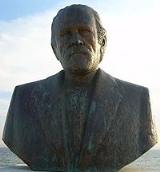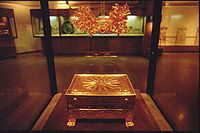
Manolis Andronikos
Encyclopedia

Greeks
The Greeks, also known as the Hellenes , are a nation and ethnic group native to Greece, Cyprus and neighboring regions. They also form a significant diaspora, with Greek communities established around the world....
archaeologist and a professor at the Aristotle University of Thessaloniki
Aristotle University of Thessaloniki
The Aristotle University of Thessaloniki is the largest Greek university, and the largest university in the Balkans. It was named after the philosopher Aristotle, who was born in Stageira, Chalcidice, about 55 km east of Thessaloniki, in Central Macedonia...
. He was born on October 23, 1919 at Bursa . Later, his family moved to Thessaloniki
Thessaloniki
Thessaloniki , historically also known as Thessalonica, Salonika or Salonica, is the second-largest city in Greece and the capital of the region of Central Macedonia as well as the capital of the Decentralized Administration of Macedonia and Thrace...
.
He studied philosophy
Philosophy
Philosophy is the study of general and fundamental problems, such as those connected with existence, knowledge, values, reason, mind, and language. Philosophy is distinguished from other ways of addressing such problems by its critical, generally systematic approach and its reliance on rational...
at the Aristotle University of Thessaloniki
Aristotle University of Thessaloniki
The Aristotle University of Thessaloniki is the largest Greek university, and the largest university in the Balkans. It was named after the philosopher Aristotle, who was born in Stageira, Chalcidice, about 55 km east of Thessaloniki, in Central Macedonia...
and in 1952 became a professor of Classical Archeology at the Aristotle University of Thessaloniki
Aristotle University of Thessaloniki
The Aristotle University of Thessaloniki is the largest Greek university, and the largest university in the Balkans. It was named after the philosopher Aristotle, who was born in Stageira, Chalcidice, about 55 km east of Thessaloniki, in Central Macedonia...
. Later he continued his studies at Oxford University with the famous professor Sir John D. Beazley
John Beazley
Sir John Davidson Beazley was an English classical scholar.Born in Glasgow, Scotland, Beazley attended Balliol College, Oxford, where he was a close friend of the poet James Elroy Flecker. After graduating in 1907, Beazley was a student and tutor in Classics at Christ Church, and in 1925 he...
(1954–1955). He came back to the Aristotle University of Thessaloniki in 1957 where he taught Archeology first as instructor and later (1964) as professor.
He was married to Olympia Kakoulidou and loved reading poetry, especially Palamas
Palamas
Palamas is a town and a municipality in the Karditsa Prefecture, Greece. Population 10,050 . Palamas is located south-southwest of Larissa, the capital of Thessaly, northwest of Lamia, north of Sofades, east-northeast of Karditsa and east-southeast of Trikala. Palamas is linked with the road...
, Seferis and Elitis. He was the founder of a local cultural group named Art .
Manolis Andronikos conducted archaeological research in Veroia, Naousa, Kilkis, Chalkidiki and Thessaloniki, but his main research was done in Vergina. The greatest moment of his life took place on November 8, 1977, when he made one of the most important archaeological discoveries of the 20th century: he found what may be the tomb of Philip II of Macedon
Philip II of Macedon
Philip II of Macedon "friend" + ἵππος "horse" — transliterated ; 382 – 336 BC), was a king of Macedon from 359 BC until his assassination in 336 BC. He was the father of Alexander the Great and Philip III.-Biography:...
at Vergina
Vergina
Vergina is a small town in northern Greece, located in the peripheral unit of Imathia, Central Macedonia. Since the 2011 local government reform it is part of the municipality Veroia, of which it is a municipal unit...
in the prefecture of Imathia. The tomb he identified as Philip's was unplundered and contained many invaluable items, such as the Golden Larnax . The finds from this tomb were later included in the travelling exhibit "The Search for Alexander" displayed at four cities in the United States from 1980 to 1982. While the discovery is of great archeological importance, the identification of the tomb with Philip has been and still is strongly disputed. Ironically enough however tried to disassociated the findings of the tomb and its findings from Alexander's father despite the support from the literature.
He was a member of the Archaeological Council (1964–1965), the Athens Archaeological Association, the Macedonian Studies Association, the Association Internationale des Critiques d' Art and the German Archaeological Institution at Berlin
Berlin
Berlin is the capital city of Germany and is one of the 16 states of Germany. With a population of 3.45 million people, Berlin is Germany's largest city. It is the second most populous city proper and the seventh most populous urban area in the European Union...
. He lived permanently in Thessaloniki
Thessaloniki
Thessaloniki , historically also known as Thessalonica, Salonika or Salonica, is the second-largest city in Greece and the capital of the region of Central Macedonia as well as the capital of the Decentralized Administration of Macedonia and Thrace...
on Papafi Street and died on March 30, 1992.
References
See also
- VerginaVerginaVergina is a small town in northern Greece, located in the peripheral unit of Imathia, Central Macedonia. Since the 2011 local government reform it is part of the municipality Veroia, of which it is a municipal unit...
- Philip II of MacedonPhilip II of MacedonPhilip II of Macedon "friend" + ἵππος "horse" — transliterated ; 382 – 336 BC), was a king of Macedon from 359 BC until his assassination in 336 BC. He was the father of Alexander the Great and Philip III.-Biography:...
- Vergina SunVergina SunThe Vergina Sun — also known as the Star of Vergina, Macedonian star, or Argead Star — is the name given to a symbol of a stylised star or sun with sixteen rays. It was unearthed in 1977 during excavations in Vergina, in the northern Greek region of Macedonia, by archaeologist Manolis Andronikos...
- MacedonMacedonMacedonia or Macedon was an ancient kingdom, centered in the northeastern part of the Greek peninsula, bordered by Epirus to the west, Paeonia to the north, the region of Thrace to the east and Thessaly to the south....
- Ancient MacedoniansAncient MacedoniansThe Macedonians originated from inhabitants of the northeastern part of the Greek peninsula, in the alluvial plain around the rivers Haliacmon and lower Axios...

